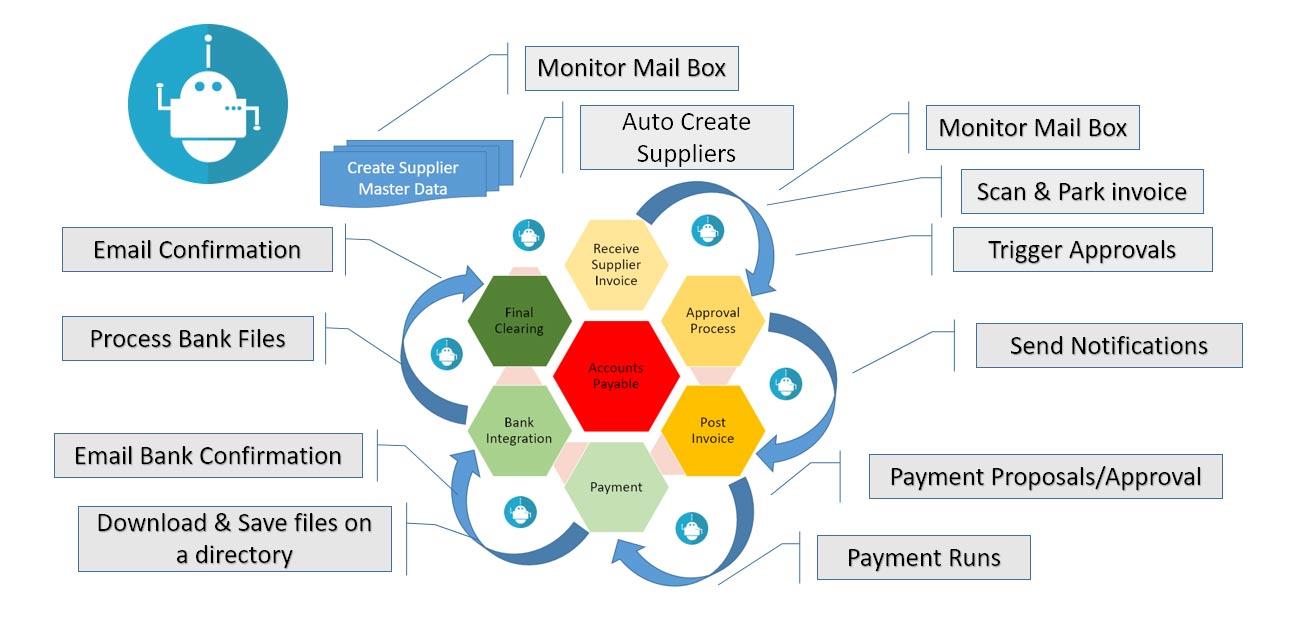Introduction
This blogs talks about how SAP S/4HANA knowledge can embark and outperform the RPA (Robotic Process Automation) journey. It’s no news that there has been a lot of talk about automation of processes. In other words, the bots can take over the manual-intensive jobs without invading the underlying fundamental processes. For a business this can result in best cost effectiveness, lowest margin of error, and most importantly optimizing the human resources. A perfect example of collaborating the ERP & Artificial Intelligence.
SAP as an ERP integrates every division of an organization. Departments such as Sales, Materials Management, Finance, Inventory etc., are deeply integrated. On the other hand, RPA blends processes seamlessly regardless of the ERP, department, or the processes involved.
A strong foundation of SAP knowledge combined with Robotics creates value for the whole organization. It does not limit the benefits to a specific department or a process. If introduced with a broader vision, and with such minimal investment, it’s hard to find a reason for a push back.
Accounts Payable Scenario
Today’s manual Accounts Payable processes are rapidly transforming. With the collaboration of ERP & RPA, the whole AP process can be automated, or in better words ‘streamlined’. An organization can now utilize their manpower effectively instead of spending time and resources on recurring and monotonous activities.
With a strong foundation in SAP, an early cross-module assessment of potential automation cases can be performed. It also plays a critical role in identifying and testing the use cases.
In the below illustration there is a potential automation in overall Accounts Payable process at each stage – supplier master creation, creating supplier invoice, payments & bank integration.

Process benefits
- Supplier Master Data: Attended or unattended bots can manage the mail boxes and utilize the required information to create/extend and update the supplier master data
- Supplier Invoice Data: With the introduction of process automation, now a bot can monitor the mail boxes and automatically scan and post the invoices in the system. This eliminates the manual capturing of invoices, data entry, which mitigates the risk of human errors
- Payment Runs: Bots can schedule the payment proposals and perform the payment runs post approval
- Bank Integration: Complete bank integration can be managed by the bots. Bots can download/upload and process the file from the bank portal into SAP
Case Study
SAP & RPA Collaboration (A European Food Giant)
With a vision to expand into the automation world, the European food giant invested in automating a tedious and error-prone process in production planning. Given the complexity of their process, errors are a serious threat to their growth. A single error could impact the overall costing process and would take hours to rectify and troubleshoot it. But, with the implementation of automation, they were able to completely overcome the shortcomings and within months their process was efficiently rolled out to multiple countries with immediate ROI.
The key to this success was attributed to the strong SAP knowledge and implementation of RPA, with the following guided road map:
- Understanding Production Planning (PP): Production Planning is a complex process in itself. A direct impact on COGS (cost of goods sold) can result in incorrect financial reporting. Before jumping to automation all the potential use cases were identified. This exercise reduced the risk of surprises, which would otherwise have increased the overall cost of the project by pushing the time lines.
- Regression Testing: As a solution architect one cannot focus only on a single process. There has to be a wider impact analysis to avoid disruption in the dependent processes – a key role in overall success of the project.
- GAP Analysis: Going for the low hanging fruits. It is important to do a proper GAP analysis and set the road map for further optimization. Trying to achieve everything in a big bang approach can be risky and would need a bigger team and budget.
Organizational Benefits
- Time-saving: With the introduction of bots, a process timeline can be reduced from hours to minutes. For example, manual data entry of 20 invoices can be fully automated, bringing down the time from hours to just minutes, needles to mention the mitigation of human errors.
- Fast-track Automation: Automation with RPA can be as quick as create, test & deploy. With the strong SAP foundation in place, gaps can be identified and fixed on time.
Now, the organization is confident enough to invest further in the automation. Currently there are many projects in their pipeline and they were able to estimate and foresee possible return on investments [ROIs] on these projects.
Conclusion
With the emerging world of RPA (Robotic Process Automation) & AI (Artificial Intelligence), it’s high time for organizations to ensure collaboration with SAP ERP to keep pace with IT transformation and make the most out of it.
Author: Karan Bhambra, SAP Principal Consultant




